M. Isidora Forrest's Blog, page 40
April 12, 2015
Isis & the Faerie Queene
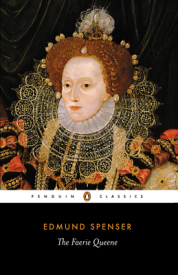
Queen Elizabeth I of England on the cover of The Faerie Queene
Did you know that Isis can be connected with Queen Elizabeth I—she for whom the “Elizabethan Age” is named?
It’s an interesting story…
It’s a story that speaks to the influence of Isis’ story throughout the ages. It is also a story that reinforces Isis’ importance as a Feminist icon.
So let us start in 1558, the year Elizabeth, daughter of Henry VIII, became queen. Elizabeth never married, thus never shared her throne; she reigned for over 40 years. She was called “Gloriana” and “Good Queen Bess” and “the Virgin Queen”.

Knox’s lovely piece of work
But this whole unmarried-queen-ruling-by-herself thing was problematic. If you think there’s sexism now, imagine 1558. Even queens were not immune. Elizabeth’s advisors were forever pestering her to marry. It was a given that women were inferior in all ways, from moral strength to intellectual strength to physical strength. “Frailty, thy name is woman,” sayeth the Bard in Hamlet to absolutely no one’s surprise. Women had virtually no rights under the law and were subject in all things to first father, then husband.
1558 was also the year that John Knox published his polemic against women rulers called The First Blast of the Trumpet Against the Monstruous Regiment [that is, “unnatural rule”] of Women. It was specifically against the Catholic queens of Scotland and England (Knox was Protestant), but as Elizabeth came to the throne in the same year, you can be sure it was applied to her as well. Knox summed up the general attitude this way:
For who can denie but it repugneth to nature, that the blind shal be appointed to leade and conduct such as do see? That the weake, the sicke, and impotent persones shall norishe and kepe the hole and strong, and finallie, that the foolishe, madde and phrenetike shal gouerne the discrete, and giue counsel to such as be sober of mind? And such be al women, compared unto man in bearing of authoritie. For their sight in ciuile [civil] regiment, is but blindnes: their strength, weaknes: their counsel, foolishenes: and judgement, phrenesie, if it be rightlie considered.
As you might expect, Elizabeth took offense and she opposed Knox, successfully keeping him from being involved in his beloved “Protestant cause” in England. Queens do have some power after all.
What Elizabeth needed was some propaganda of her own. So she carefully constructed her public image, sometimes by portraying herself as the mother of her people, sometimes as a king or prince, and sometimes by having herself compared to various Goddesses—Goddesses Who were thought, by this time, to be safely in the past. This meant that Their myths could now be used to portray queenly and Protestant values without too much consternation.
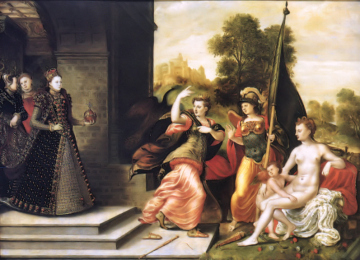
“Elizabeth I and the Three Goddesses,” by Hans Eworth, 1569; Elizabeth actually owned this painting, which both associates her with the Goddesses and has her besting Them, for she kept the golden “apple” or royal orb for herself
Sir Walter Raleigh wrote a long poem that helped promote the cult of Elizabeth as the Virgin Moon Goddess Diana. During royal functions as well as in Elizabeth’s raiment, the liberal use of the symbols of the moon and moon-like pearls helped promulgate the idea.
As war leader of her people, Elizabeth would style herself after Minerva, a Goddess capable of war, but more known for Her wisdom and love of peace. While addressing troops who were preparing to repel the Spanish Armada, she wore an Minerva-like plumed helmet and steel cuirass over a white velvet gown. She turned sexism on its head with the most famous line of her speech: “I know I have the body of a weak, feeble woman; but I have the heart and stomach of a king, and of a king of England too…”
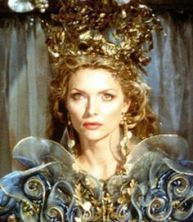
I thought Pfeiffer was awesome as the Faerie Queene, Titania
Then in 1590, Edmund Spenser wrote a long, highly allegorical poem called The Faerie Queene, which he dedicated to Elizabeth and in which he symbolically portrays his queen through various characters in the poem, including Gloriana, the Faerie Queene of the title. The poem is classic sword-and-sorcery, knights-and-damsels; Elizabeth liked it enough to award Spenser a pension for life.
It is in The Faerie Queene that we meet Isis as a symbol of Justice and equitable queenly rule. Spenser wanted to associate Elizabeth’s rule with an ancient Golden Age ruled over by another strong queen: Isis, the Divine Queen of Egypt. Spenser tells us that Isis was “a Goddess of great powre and souerainty” and that justice and equity were among Her blessings. So too are power, sovereignty, justice, and equity hallmarks of Elizabeth’s reign. Elizabeth is further associated with Isis—as well as with the famous Queen Cleopatra—by the fact that the Faerie Queene lives in “Cleopolis.”
In support of his Faerie Queene, Spenser writes that during recent history men had not properly recorded the deeds of women rulers, particularly their deeds of war. However, in ancient days (such as the time of Isis) female rulers were given the credit they deserved. He also explains that men’s jealousy of women caused them to “curb women’s liberty.”
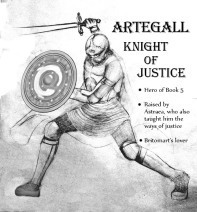
Artegall from a graphic novel
Scholars think that we are seeing the influence of the Hermetica as well as Giordano Bruno’s Egyptian-themed work on Spenser’s choice of an Isis-and-Osiris theme in Book V of the poem. Britomart, the female Knight of Chastity, is Isis-like, while the male Knight of Justice, Artegall, is Osiris-like. They are lovers, separated by various adventures, which requires Britomart to search repeatedly for Artegall just as Isis does for Osiris.
We see Britomart at her most Isian in Book V, Canto VII of the poem as she sets out to rescue Artegall from the evil Amazon queen Radigund. (Yes, it’s not all that feminist a poem.) Along the way, Britomart stops to rest at a temple of Isis (also called “Isis Church” in the poem) and is received there by the priests. The long-haired priests, dressed in silver-trimmed linen robes and moon-shaped headdresses, are in the midst of their offering rites. Britomart is amazed by the beauty of the temple, gawking openly.
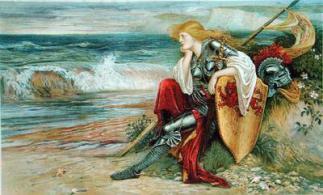
“Britomart” by Walter Crane, 1900
The priests take her to the sacred image of Isis, which is as beautifully wrought as the temple itself. The image is crowned with gold “to shew that she had powre in things diuine”, carries a wand, and with one foot treads upon a crocodile that represents both “forced guile and open force” and is being suppressed by Isis.
Britomart kneels down and prays at the Goddess’ feet. The wand in the hand of “the Idoll” moves, which Britomart takes as a sign of good fortune and falls asleep: “There did the warlike Maide her selfe repose, Vnder the wings of Isis all that night…” The priests, too, went to sleep and “on their mother Earths deare lap did lie.” They kept strict chastity and eschewed both meat and wine (especially wine).
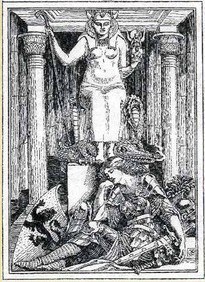
Britomart sleeping “under the wings of Isis” in Isis Church
Now Britomart dreams a dream that foretells her fate. She sees herself, as a priestess, making sacrifice to Isis. Then her linen robes becomes scarlet and her headdress becomes a crown of gold, like that of the Goddess Herself. She is in wonder, yet pleased by the change as she becomes merged in Isis. Suddenly, a wind arises that fans the altar flames and threatens to set the temple on fire. The crocodile beneath the foot of the sacred image of Isis comes to life, devours the flames and the wind, and starts toward Britomart. The image of Isis raises Her wand and beats him back.
Chastised, the crocodile now humbly comes to Britomart, begging her to love him. Which she does, becoming pregnant with and then giving birth to a great lion that subdues everything. (How’s that for a dream, eh?)
At that, Britomart wakes, confused and upset. The priests are already up, preparing for the day. Their leader notices Sir Knight’s dismay and asks her about it. She tells him the dream.
Immediately, he sees that she is of royal blood. He tells her that the crocodile represents Artegall and also the just “Osyris” Who sleeps forever beneath Isis’ foot, protected from those “cruell doomes of his.” The priest tells her that she and Artegall will have a lion-like son and start a dynasty. (Elizabeth, of course, is of this heroic line.) After rewarding the priests with gold and silver as gifts for their Goddess, the knight continues on her way.

“Prince Arthur and the Faerie Queen” by Henry Fuseli, 1788
According to Spenser’s tale, other heroes are also part of Elizabeth’s heritage, including King Arthur, the British warrior queen Boudicca, and the Anglo Saxon heroine Angela. Yet the story of Isis and Osiris, associated with Spenser’s greatest virtue, Justice, is especially important.
Though Britomart and Artegall reign with great justice for many years, eventually, Artegall is killed—by treachery—and taken from Britomart just as Osiris must eventually leave Isis to rule in the otherworld. Yet before he dies, they conceive a son, a Horus-Child who will begin the dynasty destined to lead to the reign of Elizabeth, the royal virgin who marks the glorious culmination of the Britomart-Isis and Artegall-Osiris line.
Filed under: Goddess Isis Tagged: Artegall, Aspects of Isis, Britomart, Egyptian Temples, Elizabeth I, Faerie Queene, fairy queen, Goddess Isis, Goddess worship, Isis, Isis Magic, John Knox, Osiris, Queen Elizabeth I, Spenser, Who is Isis?








April 5, 2015
Isis & the Egg

Spring! So many flowerbeds to weed…
The equinox has come and gone. Light now overbalances dark. Things are stirring, stirring, stirring everywhere. The flowerbeds beg (or is that screaming, I hear?) to be weeded and about a million springtime chores fill my ever-burgeoning To Do List.
Yet I’m feeling a little melancholy.
You, too?
Sometimes, when I’m feeling like this, I’ve found that it can be a sign that I’ve drifted a bit from my core—from Her—and that what I really I need to do is to reweave our connection. Rather than expanding as the flowers of spring so beautifully urge us to do as they break forth from the dark and muddy womb of the earth, what I need to do is pull in a bit.
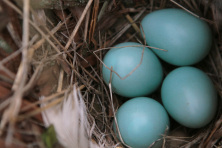
Beautiful Robin’s egg blue eggs
Fortunately, in addition to spring’s pink, yellow, and purple floral heralds, there is another springtime symbol that is almost as ubiquitous and which may be more appropriate to my inward-turning state of mind: the egg.
Like human beings always have, the ancient Egyptians knew and valued this important symbol. Indeed, one of the euphemistic names for the innermost sarcophagus (the one right next to the mummy) was “the egg.” For them, the coffin was merely the eggshell protecting the human being until she or he is ready to break free and be reborn as a Shining One among the Deities.
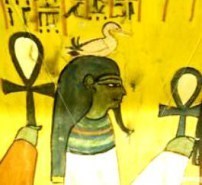
Geb, father of Isis, with the goose upon His head
As daughter of Geb (the Earth God, one of Whose symbols is the goose), Isis is called “the Egg of the Goose.” Yes, I know. God. Egg. But it is what it was, and, by tradition, Isis is the Divine Egg of Her father.
Yet Isis is a Bird Goddess Herself and has eggs of Her own, most notably Horus and the Horus-king. In the Pyramid Texts, Isis discusses with Nu, the God of the primordial abyss, how the king will be reborn by breaking out of his egg. (Remember that this is the name for the innermost sarcophagus.) First Nu states that Isis has borne and shaped the king within the egg, then asks how the Deities shall break the egg so that he can be reborn.
Isis answers, telling Nu about all the Divine help the king will get and eventually declaring, “Behold, the king is in being; behold, the king is knit together; behold, the king has broken the egg.”
After breaking out of his egg, the king is reborn, flying up from the nest like a young bird beneath the watchful gaze of his mother Isis. We find these kinds of references to the deceased as a chick in the egg throughout the funerary texts.
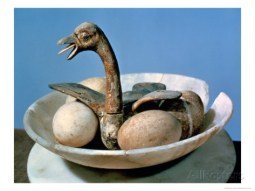
An egg-filled nest from Tutankhamun’s tomb
As they are for us, eggs were a primary food for the ancient Egyptians. So naturally, eggs were given to both Deities and the dead as food offerings. We also find examples of decorated ostrich eggs in some tombs.
Even in the later period of Isis worship, eggs continued to play their part. When Apuleius describes the purification of the Isis ship during the Navigium Isidis, he says that fire, sulfur, and an egg were used. While fire and sulfur are common instruments of purification, some scholars think the egg was added because of the importance of the egg in Egyptian symbolism.
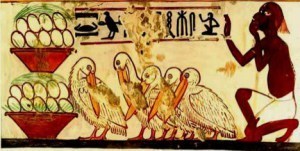
Offering baskets full of eggs
But right now—where we are right now—the egg is not yet cracked. It lies with its spring-colored companions in the grass-filled woven nest. The chick is yet quiescent. Perhaps that chick, that Isis-kite-to-be, is me. If you like, it can be you, too.
For while everything around us seems to be breaking out of its the shell, we are still within ours, humming our pre-birth song, dreaming of our Mother, still feeling Her warmth around us.

Black kite chicks hatching from their eggs; image © Jose Luis Gomez de Francisco / naturepl.com, from Arkive.org
We breathe, slowly and carefully, our eyes closed. We put our left forefingers to our lips and let is rest there. Is this the gesture of a child sucking on its finger? Is it a gesture of silence as later devotees of the Goddess believed? It doesn’t matter. It is a gesture that brings us in and quiets us. We envision the eggshell surrounding us, protecting us, as we prepare for our own true awakening of spring.
But for now, we simply float in our egg, feeling the warmth and the presence of Our Mother Isis. Her feathers cover us. She protects us. She is infinitely patient as She awaits our birth. It will take exactly as long as it takes. She has all the time in the world to wait for us.
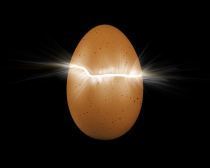
Breathe…
And as we feel Her infinite patience, we are also aware of the living cord that connects us to Her, an umbilical woven of magic that is the bond between us. This is the sacred magic of the Knot of Isis, the bond that connects the Great Goddess Isis with all Her children, whether they are within the egg or have already struggled out of their shells and are emerging in all their bewildered beauty.
But at some point, for us, the time comes. We are at last ready. We shift and try to spread our wings. We peck at the eggshell about us, cracking it. Light comes forth as we break free, emerging from the warm confinement of the egg into the pale, damp-bright, flower-scented air of spring. As we shake off the last bits of shell, Isis cries out for us: “Behold, she is in being; behold, she is knit together; behold, she has broken the egg!”
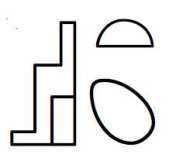
Isis’ name with the egg determinative that indicates “Goddess”
Filed under: Goddess Isis Tagged: Ancient Egypt, Aspects of Isis, Easter eggs, Eggs, Egyptian eggs, Egyptian magic, Goddess, Goddess Isis, Goddess worship, Horus, Isis Magic, Isis Rituals, Knot of Isis, The Goddess

March 28, 2015
Isis Knot Magic
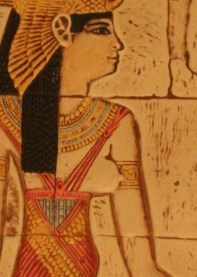
Note the knots in the straps of the Goddess’ garment as well as the little loop between Her breasts.
We’ve been discussing the famous Knot of Isis, the Tet, lately, so let’s talk a bit more about Egyptian knot magic in general.
Following that is a ritual from Isis Magic that uses magical knots for protection. The ritual can be used for any protective purpose.
In ancient Egypt, knots were used to bind and release, join opposites, and, since a knot secures things, protect.
Knot magic was well known in Egypt from an early period; an inscription in one of the pyramids states that Isis and Nephthys work magic on Osiris “with knotted cords.”
The Book of Coming Forth by Day also gives several examples of the magical power of the knot. In one, knots are tied around the deceased to help her come into the presence of the Deities: “The four knots are tied about me by the guardian of the sky [. . .] the knot was tied about me by Nuet, when I first saw Ma’et, when the gods and the sacred images had not yet been born. I am heaven born, I am in the presence of the Great Gods.”
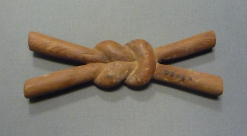
A knot amulet found at Hatshepsut’s mortuary temple
In addition to these four knots, there were seven knots, or tesut, that were tied about the deceased to protect him or her.
The power of the magical knot is in its ability to both unite and “surround” things. The tied knot is a symbol of the coming together of two things in perfect wholeness, a condition that promotes a positive outcome.
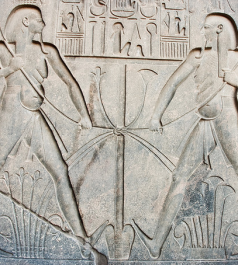
Hapi using a knot to unite the Two Lands
A passage in the Coffin Texts says that when the hair of Isis is knotted to the hair of Nephthys, the Two River Banks (the land of the living and the land of the dead) are united. Tying a knot could also refer to sexuality; the perfect coming together of two people in an act of creation. We still “tie the knot” when we get married.
Furthermore, because the two ends of the cord used in tying a magical knot symbolically go all the way around something, they “surrounded” that thing. Thus knot magic could thus be used to “surround” or “bind” an enemy—or even tie a curse to them.
In the ritual that follows, we are using the knots to surround with protection. We call upon Isis primarily, but also Nephthys, Neith, and Selket as the four Goddesses often found guarding the four corners of a shrine as well as the four Sons of Horus, Who in turn protect the canopic jars.
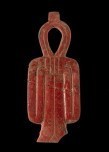
Isis protects!
The Rite of the Tet (the Knot of Isis)
About the Rite: In this rite, you will magically tie a protective knot around yourself (or around anything you wish to protect). The ritual draws upon sources in the Book of Coming Forth by Day and is, in part, adapted from an ancient rite for consecrating the Tet amulet.
Temple Arrangement: Altar at center; all tools on altar.
Ritual Tools: Nile water in Lotus Cup; petals from lotus, lily or rose flowers; Isis incense in censer; six pieces of fairly substantial red cord, each approximately one foot long (if you can’t find red cord that is thick enough, use white rope); Tet representation in any medium (if desired).
Opening
Purify and consecrate the temple and yourself according to the formulae of the House of Isis. Return to the altar, take up the lotus (lily or rose) petals and elevate them.
Priest/ess: O, you Souls of Life, Lotus Dwellers, Breathers, you of the Pure Air from the Wings of Isis, I have come for you. By the Blood, by the Power, by the Magic of Isis, establish yourselves within these petals. (Vibrating onto petals) ISET NEF!
Place some of the petals in the chalice.
Priest/ess: (Addressing petals) I know you, you shining flowers. Your name is “Life Is In It”. Your name is “Protection”. Your name is “Peace Bringer”.
Place the pieces of red cord upon the altar and anoint each of them with the Nile water with flower petals in it.
Priest/ess: (Touching each piece of cord) Isis protects!
Invocation of the Powers of Isis
Next, invoke the Goddess, raising your arms in Adoration.
Priest/ess: I call the power of my Mighty Mother Isis. I call Her strength to me. For I shall knot the cord, the Knot of Isis, and the power and peace of Isis.
O Isis, my Mother, I call Thee!
I call Thee with the breath of my body (breathing out).
I call Thee with the beat of my heart (touching chest).
I call Thee with the pulse of my life (touching wrists).
I call Thee with the words of my mouth (touching mouth).
I call Thee with the thoughts of my mind (touching forehead).
I call Thee Power. I call Thee Life. I call Thee Protection.
I call Thee, Isis!
Tying the Knots
Take up one of the pieces of red cord and move to the southeast corner of the temple. Holding the two ends of the cord in your hands, say:
Priest/ess: Thou hast Thy Blood, O Isis. Thou hast Thy Power, O Isis. Thou hast Thy Magic, O Isis. The Blood of Isis and the Strength of Isis and the Words of Power of Isis shall be mighty to (state what you wish to protect) against all that would cause harm.
With strength and intention, tie a knot in the cord and set it in the southeast corner of the temple.
Priest/ess: By the Power of Isis, I have knotted the cord.
Repeat this same procedure in the southwest, northwest, and northeast of the temple, above your head (leave the cord on the altar), and upon the ground (leave the cord at the foot of the altar).
Stand west of the altar, facing east. Make the Sign of the Wings of Isis.
Priest/ess: O Isis and all the mighty Goddesses of Protection, I call upon Thee to guard (state what you wish to protect) as Thou didst guard Osiris Himself, as Thou didst guard Horus the Child.
Isis, Mighty Magician; Nephthys, Lady of Life; Neith, Primal Mother; Selket, Powerful One—tie the Knot of Isis against all harm. Keep it away! Restrain it! Let it not come near! O, Thou Isis and all the Goddesses of Protection, grant Thy peace and protection.
If you wish to meditate or do other work, this is an excellent time to do so.
Closing
If this is a ritual for protection from some outside threat, leave the tied knots in the temple for as long as desired or needed and conclude the rite by making the Sign of the Wings of Isis at the altar and speaking the last line.
If this rite was worked simply to create peace for meditation, you may untie the knots when you are finished by simply going to each knot in the order you tied it and untying it.
Priest/ess: I have untied the knot. Be in peace, O Thou Blood and Power and Magic of Isis. Be in peace.
Take each piece of cord to the altar. [Skip to here if you are leaving the Knots tied.] At the altar, make Sign of the Wings of Isis.
Priest/ess: I thank Thee, Isis, in all Thy names of Protection. Hold me ever near Thee, bound by Thy protective knots.
Quit the temple.
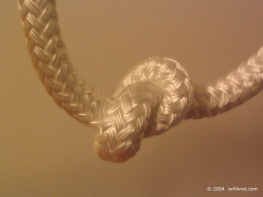
Use a simple, overhand knot in this ritual
Filed under: Goddess Isis Tagged: Aspects of Isis, Egyptian magic, Goddess, Goddess Isis, Invocation of Isis, Isis, Isis knot, Isis Magic, Isis the Magician, Knot magic, Lady of Magic, Neith, Nephthys, Osiris, Selket, Tying the knot

March 22, 2015
Where does the Isis Knot come from?
Did you know that there is a yearly scholarly conference called the Conference of Isis Studies?
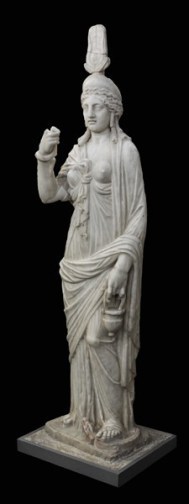
A Greco-Egyptian Isis from the Alexandrian suburb of Ras el-Soda, with most of the attributes
It started in 1997 as a small conference devoted to studying the diffusion of the worship of Isis in the Mediterranean and to fostering contact between researchers who study the Goddess. The proceedings of the conference are published every year by Brill, a wonderful scholarly publisher.
Most of the articles are either in French or English, and in general, of interest only to the deep scholar. The minutia of much of it can get a bit boring for even the Isis-focused reader. However, I usually skim the proceedings to see if anything new and fascinating has come to light. And I do wish I read French better.
I came across something in a semi-recent volume that is indeed of interest. Remember that this conference originally got started to study how the worship of Isis spread?
Well, I didn’t know that one of the theories scholars have been testing is whether there was some kind of “ur-statue” of Isis that served as the model for Her representation throughout the region. In other words, they are wondering whether there was one particular statue that became famous and was then copied by other people wanting an image of the Goddess for their shrines or temples. Presumably, this ur-statue would have the curled locks, a headdress of vaguely Egyptian style, a sistrum, perhaps a situla, and importantly, the famous Isis knot tied into the image’s robes.
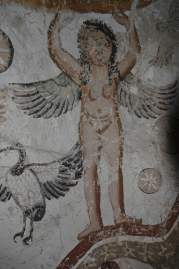
The corkscrew hairdo from the Tomb of Petosiris
So they try to find the earliest examples of these various attributes to see whether they can find some ancient example of the Isis statue with all or most of the attributes.
I’m looking at Robert Bianchi’s work on this right now. He thinks that the earliest example of the corkscrew curls hairstyle may be from the tomb of Petosiris, 4th century BCE. However, the style is not on Isis, but rather on a winged female figure on the ceiling of the tomb. Isis Herself appears to be wearing a standard braided Egyptian wig.
Bianchi thinks the curls are from Greek influence and cites numerous examples of Greek statuary, such as the korai and Athena, with these long, curled locks.
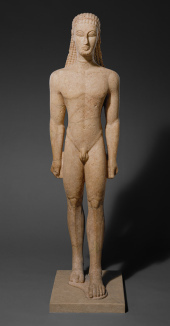
An early Greek kouros looking very Egyptian-influenced
However, it is important to note the original influence of Egyptian sculpture on early Greek sculpture, most especially the kouroi. So perhaps it was another example of Egyptian influence flowing into Greece, then being returned from Greece to Egypt.
But rather than Isis’ curled hair, today I’m interested in Her famous Isis knot. By the time Isis’ worship moved out of Egypt and into the greater Mediterranean world, the Isis knot was indeed an Isis knot—and serves as a marker for the identity of the Goddess in Her images and those of Her priestesses.
When and where did that first appear?
We have already discussed the precedent for the Isis knot in New Kingdom women’s clothing, especially royal women’s clothing.
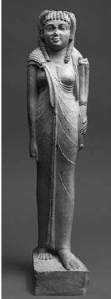
Arsinoe II with Isis knot dress and missing her headdress

Arsinoe III with knot and headdress
But it appears to have been the Ptolemaic queens—who were often identified with Isis and Hathor/Aphrodite specifically—who eventually turned the royal knotted outfit into an attribute of Isis specifically.
The earliest instance is Arsinoe II (born 316 BCE) on a monument known as the Pithom stele. Notably, Arsinoe is deceased on the stele and wears the knotted costume and Goddess headdress and is called “the image of Isis and Hathor.”
Arsinoe III is also shown wearing the knotted garment and headdress and she, too, is sometimes assimilated with Isis, for example, in inscriptions that blessed the queen as “Arsinoe Philadelphus Isis.”
By the time of Kleopatra III, Isis had gained more prominence and the queen was more and more connected with Her. When Kleopatra III gave birth to a son, she became “Isis, Mother of the God.” What’s more, because the child had the same birthday as the Apis bull, Kleopatra III also became the “Isis cow,” the Mother of Apis. It is more than likely that Kleopatra III encouraged these types of identifications as she was in an intense rivalry with her mother, Kleopatra II, to whom Ptolemy VIII was still married when he also married his niece, Kleopatra III. Talk about complicated relationships. Ptolemies.
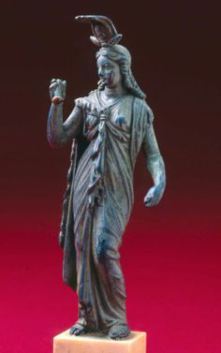
A Roman bronze showing the Isis-knotted garment, horns & disk crown, and probably carrying the sistrum and situla, now missing
Then finally, by the time of the last of the Ptolemies, Kleopatra VII identified herself completely with Isis as “The New Isis.”
By the end of his study, Bianchi concludes that there were enough different representations of Isis the Many-Named that it is not likely that there was a single ur-statue of the Goddess. However, and interestingly, he says that the Isis knotted garment does seem to have been reserved for Isis when She was being portrayed as especially “Egyptian.”
What this meant in practice was that when Isis wore the Isis knot, She was often also supplied with other images that tied Her more strongly to Egypt, such as a crocodile, Anubis, a cobra, or an Osiris Hydreios (an image of Osiris that gave Him a human head on what appears to be a vessel, although many of them were not hollow and could not have contained the Nile water associated with Osiris).
So here’s the trail so far: the knotted garment was originally an Egyptian fashion, especially seen on royal and noble women. The Ptolemaic queens, who were Greek but trying to be more Egyptian, adopted the knotted garment as an outfit that Egyptian royals wore. As part of “becoming Egyptian” the Ptolemies promoted the cult of Isis, Osiris/Sarapis, and Horus/Harpokarates. Egyptian tradition already associated the pharaoh with Horus, the son of Isis. To emphasize their Egyptian-ness, the Ptolemaic queens began to associate themselves with Isis and with Hathor. By the end of the dynasty, Isis was the more prominent and the queens, wearing their Egyptian knotted outfits, were strongly identified with Isis.

An incredibly sensual image of an unknown Ptolemaic queen with the knot between her breasts
As Isis’ worship was spreading outside of Egypt at this time, non-Egyptian artists looked to Egypt for the way to portray the Goddess. Naturally, they looked to the queens. They then used the knotted garment, along with other symbols, to indicate that this particular image is indeed intended to be Isis Herself.
But that just has to do with imagery. In Egypt, the knot is more than just practical, it is also magical. And as Isis is Goddess of Magic, you may rely on the fact that She can do magic with knots. Thus modern Isiacs may be able to see the Isis knot as a visual emblem indicating the Goddess Isis, as well as a symbol of Her magical power.
I’ve run out of time and space this week…so next week, we’ll have ritual from Isis Magic that uses the power of magical knots for protection.
Filed under: Goddess Isis Tagged: Ancient Egypt, Aspects of Isis, Deities, Egyptian magic, Goddess, Goddess Isis, Greco-Roman Isis, Hellenistic Isis, Isis, Isis & Hathor, Isis knot, Isis Magic, Isis Rituals, Ptolemaic, Ptolemies, Who is Isis?

March 15, 2015
Saying “Isis” in Egyptian—Updated
This is a revised and updated version of how to pronounce Isis’ name in Her native tongue. The original post was getting a little long in the tooth and needed updating. The explanation is easier to understand and more complete now. Never stop learning ;)
Until recently, with the advent of Kemeticism, the name of Egypt’s Great Goddess Isis was almost invariably pronounced “Eye-sis.” That’s the Anglicized version of what the ancient Greeks called Her: Ἶσις (Ee-siss). For the sake of familiarity, that’s the version I still generally use in this blog. But when I want to go full Egyptian, I represent Her name as Iset. Here’s why:
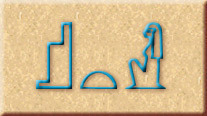
These are the most common hieroglyphs for Isis’ name in Egyptian.
In Egyptian, Isis’ name was most often spelled with the hieroglyphs throne, semi-circle (also called bread loaf), Goddess, although during the thousands of years of Her worship there were a number of variant spellings. Egyptian artists commonly designated Isis by painting the throne hieroglyph on Her crown. Thus it is possible to identify the shortest version of Isis’ name with the throne itself.
Because the hieroglyphs include only consonants, we do not know precisely how the ancient Egyptians would have pronounced Her name. But we do have clues. The throne hieroglyph is a biliteral symbol, that is, a single symbol representing two sounds. The semi-circle is a monoliteral, or single-sound glyph, and represents our letter t. In this case, it provides the feminine ending of the word just as in English we might add -ess to feminize a word. The Goddess symbol is a determinative and provides the overall concept of the word, but has no sound.
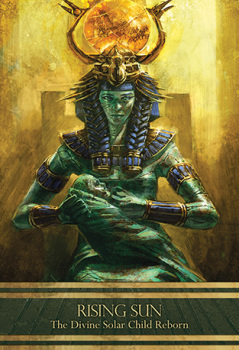
An amazing Green Isis from Alana Fairchild’s Isis Oracle deck
The first of the two sounds comprising the biliteral throne symbol is a consonant similar to the Hebrew yod* and is represented by modern Egyptologists as ı͗ . The yod sound is similar to English y or i, but remember that it is a consonant, not a vowel. In hieroglyphs, it is represented by the reed flower glyph. The second of the two sounds in the throne is an s. Between the yod and the s, any vowel could have been inserted. Similarly, a vowel could be inserted between the throne and the semi-circle. So how can we know which vowels were used?
The ancient Coptic and Greek languages provide some information. Coptic was a late form of Egyptian that uses Greek letters to represent Egyptian sounds. By the time Egyptian had evolved into Coptic, Isis is Êse, pronounced Aay-seh or Ee-see (the final t was dropped in spelling by this time, and likely in pronunciation much earlier). From their earliest encounter with Egyptian religion, the Greeks—and most importantly those Egyptians who wrote Greek—spelled Her name asἾσις, which they would have pronounced as Ee-siss. In Late Antiquity, they sometimes added an epsilon at the beginning so that an alternative pronunciation would have been Aay-siss. So from examples of Her name in Coptic and Greek—contemporary pronunciations that were actually being used by the people who recorded them—we can narrow the search for initial vowels down to either an ee sound or an ay sound. We can be fairly sure, then, that the first syllable of the Goddess’ name was in earlier times Eess and in the late period had changed to Aayss. (How could it have changed? In the same way that modern English no longer sounds like Chaucer’s English, so ancient Egyptian was spoken for thousands of years and naturally morphed during that time.)
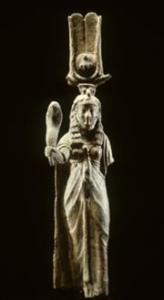
A Late Period Ese
Between the throne and the semi-circle, we insert a generic e before the final t to create the feminine ending in line with the Egyptological convention of representing the feminine ending as et as in Amunet, the feminine form of Amun. (It is entirely possible that this e could have been another vowel, for example, i.) Nonetheless, by combining the information we have about Her name as pronounced in Coptic and Greek with current scholarly opinion on Egyptian pronunciation, it is most likely that Isis in Egyptian would have been pronounced Ee-set and in Late Antiquity also as Aay-set. Either of these could have been Hellenized to Isis by replacing the -et ending with the Greek -is ending. Finally, we Anglicize the name Isis to Eye-sis.
Of course, all this is just for the sticklers among us. Isis will know those who call upon Her no matter what name we use. The various pronunciations of Her name are of interest mainly because of the emphasis that the Egyptians themselves placed on knowing the true name of a Deity, person, or thing in order to know its essential nature.
Pronouncing the Goddess’ name correctly is a courtesy we can do for Her. Yet because She is also the Lady of Ten Thousand Names, we can correctly use any of the various pronunciations of the Goddess’ name and thereby touch different aspects of Her nature. For example, to contact a very Egyptian form of the Goddess, we might invoke Her by the name Iset. For a more Hellenized aspect, we might call upon Isis using the Greek pronunciation, Ees-ees. Many people will call upon Her as Great Goddess using the Anglicized version of Her name, Eye-sis. In any and all of these names, we will still be contacting the energy of the Goddess Isis. The difference will be not in the essence of the Goddess, but in the particular “flavor” of Her energy that may be contacted by using different names and languages to invoke Her.

Iset on the foot of the outer coffin of the mummy of Ankh-Wennefer, Washington State History Museum; photo by Joe Mabel, wikicommons
In the Book of Coming Forth by Day, better known as the Book of the Dead, Isis is called Iset Nudjerit em Renus Nebu, “Isis, Goddess in All Names.” Perhaps, we can see Her not only as the Goddess of All Names, but of All Pronunciations as well.
* A century ago, in his hugely influential books (still so because Dover keeps them readily available), Sir E.A. Wallis Budge used a peculiar set of symbols to transliterate the hieroglyphs, and one of them in particular continues to confuse readers to this day. Instead of the ı͗ used by other Egyptologists and often called yod (borrowing the name of the Hebrew letter), Budge represents the reed flower as å (that’s not quite it; the dot should be solid, but it was all I could get WordPress to do.) And don’t get me started on Budge. You can see my comments on Budge-hating here.
Filed under: Goddess Isis Tagged: Ancient Egypt, Aspects of Isis, Egyptian magic, Goddess, Goddess Isis, Isis, Isis Magic,

March 7, 2015
Isis & Hathor, Together Again

The partially restored Temple of Hathor on neo-Philae (Agilkia) island
I missed last week’s post as I was off visiting some wonderful magical people in Florida (waves fondly at them). If any of them are reading this blog, they will immediately understand why this week’s post is dedicated to Isis (especially Heavenly Isis) and the Golden One, Hathor.
On the island of Philae, east of the Temple of Isis, stands a smaller temple to Hathor. The Hathor temple was restored, at least in part, in 2012 and reopened to the public. (Both the Isis and Hathor temples, as well as the other temples of ancient Philae are now on the Egyptian island of Agilkia, aka Agilika, where they were moved prior to the building of the Aswan Dam, which created Lake Nasser and flooded Philae.)
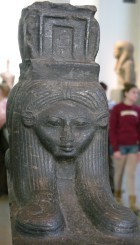
A lovely Hathor head, from a processional boat, now in the British Museum
Compared to the Temple of Isis on Agilkia, the Temple of Hathor is quite small. Reciprocally and interestingly, at Denderah, Hathor’s great Ptolemaic temple complex, there is a similar small Temple of Isis. Clearly, there is a relationship between these two Great Goddesses; so much so that it was required that each Goddess would have a smaller temple near the great temple of the other.
In fact, sometimes that relationship between Isis and Hathor is so close that it’s hard to tell Them apart. Beginning in the New Kingdom, we regularly see Isis wearing the Horns & Disk crown of a Cow Goddess that is emblematic of Hathor. Sometimes Isis also has a small throne on top of the Horns & Disk to indicate that She is indeed Isis rather than Hathor, sometimes She doesn’t. But guess what? Hathor sometimes borrows Isis’ headdress, too.
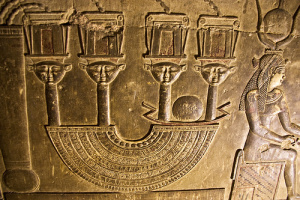
Hathor wearing the Horns & Disk AND the Isis throne
Again at Denderah, we find a carving of Hathor—and the hieroglyphs confirm that She IS Hathor—wearing the Horns & Disk with the throne on top. I couldn’t find a great photo of it, but if you look above the disk, you see a little bump. That’s the bottom of the throne.
Both Isis and Hathor are associated with Horus, Isis as His mother, Hathor sometimes as mother, sometimes as lover. Both are Cow Goddesses and Goddesses of the Sycamore, though Hathor probably has the prior claim on both these symbols. Both are Eyes of the Divine and holy Uraeus Serpents, powerful, fiery, protective and vengeful Goddesses. Thus both can become Sekhmet, that most fierce and bloodthirsty of Goddesses. Both Isis and Hathor are Goddesses of the Otherworld, Goddesses of rebirth and resurrection, Whom the dead ones adore.
Looking just as these correspondences, Isis and Hathor seem interchangeable. Is it so?
I don’t think so. Instead, They are sister branches of the Divine Tree. They are ultimately united in the Tree’s trunk, yet there is a quite palpable difference in the energy feeling of the two Goddesses—at least out in the twigs and leaves of the Tree where we most often experience Them. As you know, I have an enduring dedication to Isis, but in another part of my spiritual life, I also have a strong connection to Hathor.

Hathor is one of very few Egyptian Deities depicted full face
Hathor’s energy always has an underlying feeling of excitation, of arousal. It may be sexual, but it doesn’t have to be. Hathor imparts the excitement of living, and thus She is the Great Lady of Love, Joy, Drunkenness, and Dance. Her symbol par excellance is the sistrum, the sacred rattle that is shaken to stir things up. In Egyptian, to “play the sistrum” is iri sekhem, to “do power.” Hathor has something of the maenad in Her, if I may draw from a different cultural metaphor; She’s a bit more wild than Isis, more likely to roar or hiss or spit. O, but She will dance you to ecstasy; She will love you to ecstasy; She will sing you to ecstasy. Perhaps She will also put a bit of Divine terror into your belly while She’s doing it. But then She will turn Those Eyes upon you, those soft, bright, deep cow’s eyes, and She will soothe you, take you in, and make you understand that Love, only Love, is at the heart of the Divine reality.
Of course, Isis, too, inspires passion. She certainly inspires it in me. But that’s not the foundation of Her energy. At Isis’ heart is strength interwoven with the numinous power of magic. Hathor’s tingle is the excitement of life and love. Isis’ tingle is heka. Yet the Mystery of the Goddesses is such that They can share many or even most of Their symbols. Blessed be the Ladies.
Filed under: Goddess Isis, Modern Paganism Tagged: Aspects of Isis, Egyptian Deities, Egyptian Temples, Goddess, Goddess Isis, Goddess worship, Hathor, Isis, Isis & Hathor, Isis Magic

February 15, 2015
Isis, Lady of Crocodiles?
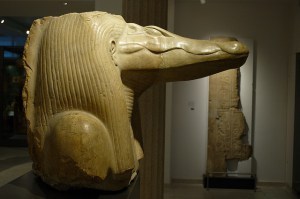
Sobek, the Crocodile God
We don’t usually think of Isis in relation to crocodiles or to Sobek, the Crocodile God. Ahh, but wait. As with so much in Egyptian religion, it’s complicated. And there are more Isis-croc connections than we might at first think.
Let’s start with a bit about the crocodile itself. A Nile crocodile can reach up to twenty feet in length—and it doesn’t care what it eats. In addition to their usual diet of fish, the Nile crocodile is happy to feed on birds, wild and domestic animals—and human beings. Estimates are that as many as 200 people a year are killed by crocodiles. Crocodiles catch their prey in huge, toothy jaws and drag it underwater until the struggling stops. It is no wonder Egyptians ancient and modern fear the beast. Perhaps that fear explains why the Nile crocodile was hunted nearly to extinction in the 1940s through 60s. Today, however, they have rebounded and are no longer in danger.

The impressive Nile crocodile
The image of the strong, voracious, and fierce crocodile appears in Egyptian art beginning in prehistoric times. Yet, they are shown both as devouring monsters and as protective guardians. Ammut, Who waits to devour the dead who fail the judgment of Osiris, is part crocodile. Yet magic wands designed for protection often include images of crocodiles. A protective amulet called the Cippi of Horus showed the Son of Isis standing upon the backs of two or more crocodiles and holding dangerous serpents harmlessly in His hands. Powerful magicians were fabled to be able to ride across the river on the backs of crocodiles.
Yet most people wanted to repel crocodiles. Numerous magical formulae have been found that were uttered to keep the frightful creatures at bay, many of them including the important words, “Get back, crocodile!” Jokingly or seriously, I have used that spell on the road when another vehicle comes way too close.
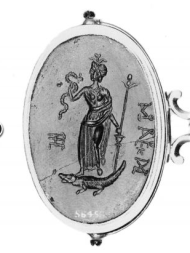
Isis standing on a crocodile on a magical gem
The crocodile was a presence in the Egyptian world that simply could not be ignored. And as the God Sobek, the Egyptians gave Him His due. Sobek is a Water God and thus associated with fertility. There was a common folk belief among the ancient Egyptians that when many crocodiles were seen in the Nile, the flood waters of the annual Inundation would be deep and, as a result, the harvest would be abundant.
Sobek is also connected with original creation; for as the crocodile rises up out of the Nile, so the primordial Sun arose from the waters of chaos. Because of this solar connection, Sokek is frequently seen crowned with the solar disk. The God’s major centers of worship were at Kom Ombo, upriver from Philae and Aswan, and in the Faiyum, a large, especially fertile oasis in Lower Egypt, southwest of Cairo. We also have some evidence of His cult in Memphis, perhaps within the Ptah temple complex.
Both Memphis and the Faiyum were places where Sobek and His myth met up with Isis and Hers. The Faiyum was the center of Sobek worship and sacred crocodiles were bred and raised at the God’s temples. The historian Herodotus remarks on the Egyptians’ treatment of these temple crocodiles: “they put ornaments of glass and gold on their ears and bracelets on their forefeet, provide for them special food and offerings and give the creatures the best of treatment while they live; after death the crocodiles are embalmed and buried in sacred coffins.”
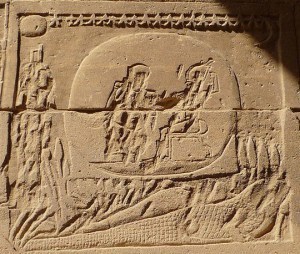
A rather destroyed image of Osiris on the back of a crocodile, Isis before them, from Philae
When the Faiyum temple of Medinet Madi was unearthed, some of the first things they found were four lengthy praise hymns to Isis as universal Goddess, in Greek, and written by Her devotee, Isidorus. In these hymns, Isis is understood to be many Goddesses, including Isis-Thermouthis or Hermouthis. This is Isis assimilated with the Cobra Harvest Goddess Renenutet. In the Faiyum She is paired with Sobek.
Further excavation at Medinet Madi revealed a Middle Kingdom temple of Sobek, Renenutet, and Horus, which is the only Middle Kingdom temple discovered to date. You can see why it was easy to connect Isis, Who sometimes takes the form of a cobra, with the Cobra Goddess Whose child is Horus. During the 12th dynasty, when the pharaohs took a particular interest in Sobek and the Faiyum, Sobek came to be assimilated with Horus. A text from Denderah tells us that Horus takes the form of a crocodile to retrieve Osiris’ body from the water. In another tale, Sobek Himself was said to assist Isis during Horus’ birth. On the other hand, it was also said that Sobek was the one Who devoured Osiris’ phallus when it was thrown into the Nile, for which offense Isis cut out His tongue. The tale explains why the crocodile has no tongue. (They do have tongues, but their tongues are not free, being held in place by a membrane.)
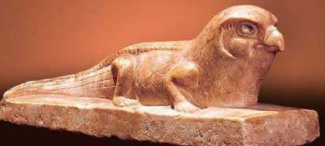
Horus-Sobek or Horus in the form of a crocodile
In one of the hymns to Isis from Medinet Madi, Sokonopis (“Sobek of the Nile”) is called “Agathos Daimon (“Good Spirit”),” “mighty,” and “that goodly bestower of wealth, creator of both earth and starry heaven, and of all rivers, and very swift streams.” Two other Isiac consorts, Serapis and Osiris, are also called Agathos Daimon. Like Sobek, both Serapis and Osiris are associated with water and especially rivers. Serapis is connected with a miracle in which pure water is produced from salty. Osiris is the living water of the Nile Inundation itself.
Isis-Thermouthis and Sokonopis were considered healing Deities, an ability that may have accrued to the Crocodile God from His association with Isis, the Healing Goddess. The Crocodile God was said to have assisted Isis in healing Osiris. In fact, there are a number of representations of a crocodile bearing the Osirian mummy on its back. One of these is from Philae, where Isis is shown standing at the feet of the crocodile-carried Osiris. This idea surely came from the fact that mother crocodiles will sometimes carry their young on their backs to protect them from predators. Plutarch relates an Egyptian tradition that, out of fear and respect for the Goddess, crocodiles will not attack people traveling in papyrus boats because Isis traveled in such a boat as She searched for the parts of Osiris’ body.
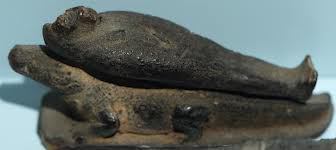
A statuette with Osiris on the back of a crocodile
Isis’ association with the crocodile continued long after the end of ancient Egypt. There is a famous work called The Faerie Queene, written by the Elizabethan poet Edmund Spenser. Spenser is writing in support of his monarch, Elizabeth I. In his story, the heroine finds herself in Isis Church and has a vision of the Goddess. At first, she sees herself as a votary of Isis, later she becomes Isis Herself. A crocodile threatens to destroy the Church, but our heroine, as Isis, drives it back. Tamed, the beast now seeks her “grace and love.” Literally. For the crocodile mates with her/Her and she/She gives birth to a lion. A priest at the Church explains that the crocodile is Osiris and their lion-child will be a just king.
And so we see that Isis and the crocodile are much closer than it might at first seem. Like the Goddess Who, in Her dark and bright aspects, can be both frightening and comforting, the Crocodile God Who is Her Faiyum consort can be fearsome, as well as a protector, healer, and a giver of wealth. When it comes to Goddesses and Gods, it’s definitely complicated.
Filed under: Goddess Isis Tagged: Aspects of Isis, Crocodile, Deities, Egyptian Temples, Faiyum, God Sobek, Goddess, Goddess Isis, Isis, Isis Magic, Lady of Magic, Pagan Spirituality, Sobek, Who is Isis?

February 8, 2015
Isis in the News & in Art
I have almost given up all my Google Alerts with “Isis” in them due to the horrors that have too frequently arrived in my inbox with those tags. But I kept one: “Goddess Isis”.
And yesterday, finally, some good news came in and made my inbox happy.
Apparently, there was a recent conference at the Italian Cultural Institute in Cairo in which scholar Marco Ruggiero talked about vestiges of Isis worship in and around Naples. While the summary provided in the article (link below) is interesting, I would love to have a transcript of the whole talk. If we’re lucky, maybe it will show up on academia.edu.
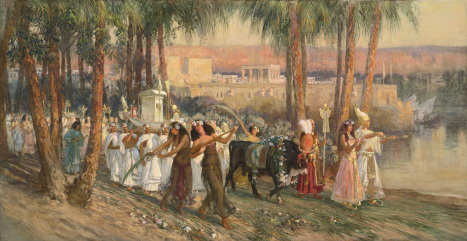
Frederick Arthur Bridgman, A Procession in Honor of Isis or An Egyptian Procession, 1902. Click on the image to see all the details; it is worth doing, I promise.
As you’ll see when you click through, this is the image used to illustrate the article. I was aware of this painting and have even used it on Isiopolis before, but I didn’t really know anything about it. So I thought I’d look it up.
Born in 1847, Bridgman was an American painter famous for his “Orientalist” subjects. He mostly worked in Paris (it was THE place to be an artist at the time) but he did travel to Egypt, where he made hundreds of sketches that would later become paintings like this one.
Apparently, the original of this painting was called Procession en l’honneur d’Isis, (“Procession in Honor of Isis“) and won great acclaim when it was first exhibited in Paris. We don’t know where that painting is at present. This one, An Egyptian Procession, Bridgman painted as a variation on the Isis one, though it, too, must be intended as an Isis procession since Isis’ Philae temple is in the background.
Catalog notes from Sotheby’s says of the painting, “Bridgman made sketches at the fabled site [Philae] first in 1874 and again during his numerous subsequent visits to the region; these, combined with his diligent research into the manners and customs of the ancient Egyptians, allowed him to create a remarkably vibrant—if ultimately over-embellished—scene of ritual and revel. It is worth noting that the setting of Bridgman’s picture would have been particularly resonant in 1902—this was the year that the Aswan Low Dam was built by the British, threatening the monuments at Philae by changing the rise and fall of the surrounding Nile River.”
So there are your Isis art notes for the day. Now on to the article: Here’s the link.
Filed under: Goddess Isis Tagged: Ancient Egypt, Frederick Arthur Bridgman, Goddess, Goddess Isis, Isis, Isis Magic, Isis Rituals, Orientalist painting, Procession in Honor of Isis

February 1, 2015
Isis & Wine

Isis chardonnay from Malta
Last week, bread. This week, wine. For as the poet says, paradise requires only a loaf of bread, a jug of wine, and Thou, Isis. I may have added that last bit.
As it turns out, both my Deities are Wine Deities. Although my Lord D is more known for His wine-y associations, Isis too, is a Goddess associated with wine.
The grapevine is not native to Egypt, but by the early third dynasty, Egypt had a viticulture industry all its own. Still, wine was expensive and it was generally reserved for the wealthy and priestly classes, for tomb offerings, and for the Goddesses and Gods. The Egyptians made both red and white wines; a Greek writer commented quite favorably on the quality of Egyptian white wine. Due to its Mediterranean climate and the greater availability of water, most ancient Egyptian vineyards were located in the Nile delta.
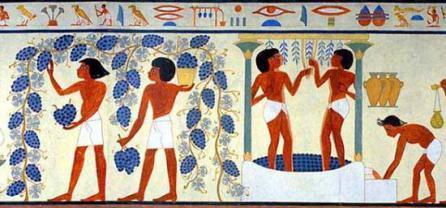
Egyptian grape harvest and winemaking
Several delta cities had a reputation for their fine wines, including Sebennytos, the town near Isis’ great temple at Isiopolis. It was common for temples to have their own vineyards. There was even a tradition in Egypt that, on occasion, the water of the Nile turned to wine. Epiphanius, the early Christian polemic writer, tells us that many people attested to this Nile-water-into-wine miracle. Of course to Epiphanius it was a Christian miracle, taking place on the 6th of January and commemorating Jesus’ water-into-wine miracle.
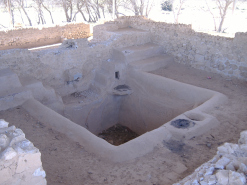
An Egyptian winepress
The Goddesses Hathor and Bastet are both associated with wine and beer, especially during Their Festivals of Intoxication where imbibing was part of the worship. The Winepress God, Seshmu, is also known from the funerary texts. He brings grape juice to the king for wine production, gives wine to the deceased—and crushes the heads of enemies and wrongdoers in His bloodthirsty winepress.
Yet if there is one Egyptian Deity Who has the most right to the title of God of Wine, it is Osiris, the husband of Isis. Osiris is known as Lord of Wine as early as the Pyramid Texts and His identity as such only grew as time passed. In a magical papyrus from the second century CE, the “blood of Osiris,” clearly wine, is poured into a wine cup, and is to be given to a woman as part of an erotic spell: “Give it, the blood of Osiris, that he gave to Isis to make her feel love in her heart for him night and day at any time, there not being time of deficiency.” No doubt, the

Noble ladies enjoying their wine
association of Osiris with wine is the reason that one story tells us that Isis became pregnant with Horus by eating grapes. Isis Herself is also given the epithet Mistress of Wine and Beer.
In addition to Her marriage to the Lord of Wine, Isis has Her own associations with the vine and with the Greek Wine God Dionysos. The Greeks considered the sacred star of Isis, Sirius, to be the bringer of wine since its late-summer rising coincided with the beginning of the harvest season. Ancient writers also speculated on a variety of Isis-Dionysos connections. One said that Dionysos is the son of Zeus and Isis. Another called Isis the daughter of Prometheus and said that She lived with Dionysos.
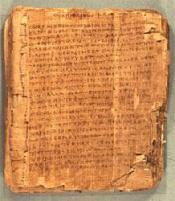
The Ebers Papyrus begins with a prayer to Isis, Great of Magic
Wine can also be associated with Isis as a Healing Goddess. Wine and beer were the delivery media for many an ancient remedy. Ancient medicines often listed a variety of herbal ingredients to be put into wine, then the patient was to drink the potion for a particular number of days. And, of course, as Goddess of Magic, Isis is often part of the cure for “Magic is effective together with medicine. Medicine is effective together with magic,” according to the Ebers medical papyrus. The papyrus even begins with a prayer to Isis, Great of Magic.
As for other Deities, wine was a common offering to Isis. Due to its costliness, it was a valuable offering, but wine was also thought to temper the sometimes-fierce nature of the Goddess. For, like Hathor and Sakhmet, Isis could be offered wine to “make Her heart rejoice” so that She would not be angry. Temples of Isis in Egypt and even further afield bear evidence of offerings of wine. Isis’ temple at Philae has wine-offering scenes carved on every doorway lintel down the central axis of the temple, as well as in side sanctuaries and on exterior walls.
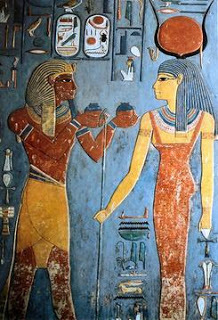
Offering wine to Isis
A wine cup dated to 73 CE was found in a shrine of Isis on the island of Paos in the Aegean and includes an inscription to “Isis the Great.” An ancient Roman wine jug discovered in Southwark, England has an inscription that reads: Londini ad Fanum Isidis (“to the Temple of Isis in London”).
Wine vessels are included in the Roman Isis procession described by Apuleius, yet candidates for initiation into the Mysteries of Isis had to refrain from drinking wine for ten days before an initiation.
Isis, the Mistress of Wine, is married to Osiris, Lord of Wine, and Their Holy Child is conceived by the consumption of grapes. And so our Lady is both the green Goddess of the vine and the purple Goddess of the wine.
Filed under: Goddess Isis Tagged: Aspects of Isis, Ebers papyrus, Egyptian magic, Egyptian wine, Goddess, Goddess Isis, Goddess worship, Isis, Isis Magic, Isis wine, Lady of Magic, The Goddess, Who is Isis?

January 25, 2015
The Divine Bread of Isis
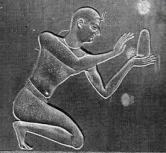
Offering bread to the Goddess
Ahhh. There is absolutely nothing like the smell of fresh bread, hot from the oven. Add butter and I’m in heaven.
Yet with so many of us on gluten-free diets because of gluten intolerance or celiac disease—and with some arguing that eating grain is literally killing us even if we’re not gluten-intolerant or celiac sufferers—well it seems that bread has been both refused and abused of late.
And so today I write in defense of bread—as a worthy offering to Isis and Her Divine family and as a powerful symbol of transformation.
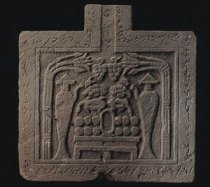
An offering table with the oval-shaped loaves of bread and pitchers of wine already and eternally upon it
Indeed, the offering tables of ancient Egypt fairly groaned beneath the weight of loaves of offered bread. In tomb paintings you can see them, baked into neat, conical or oval shapes and piled high upon the altars. “Thousands of loaves” were promised to Deities and deceased pharaohs. Excavations have shown that actual loaves of bread were among the grave goods of kings and commoners alike. In the Book of Coming Forth by Day, the deceased declares he will live on the bread of the Goddesses and Gods.
As in so many places in the world, bread in ancient Egypt was a basic, even archetypal, food and the grain from which it was made, an essential, as well as symbolic, food crop. To the ancient Egyptians, a loaf of bread came to symbolize all types of food offerings and all good things.
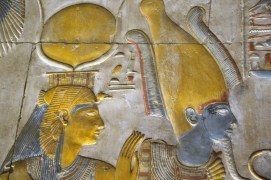
Lady and Lord of Green Crops
Both Isis and Osiris are strongly connected with bread and the grain from which it is made. A number of Isis’ epithets attest to this. She is the Lady of Bread and Beer, Lady of Green Crops, Goddess of the Fertility of the Field, and the Lady of Abundance. (And by “bread and beer” the Egyptians meant more than just a sandwich wrapper and a drink. The phrase meant every good thing; Egyptians would even greet each other by saying, “bread and beer,” thus wishing each other prosperity.)
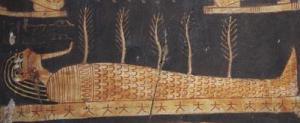
I live and grow as Grain…
For Osiris’ part, like so many Gods, He is identified with cycle of the living and dying grain. The Coffin Texts connect Osiris and grain with immortality: “I am Osiris . . . I live and grow as Neper [“Corn” or “Grain”], whom the august gods bring forth that I may cover Geb [the earth], whether I be alive or dead. I am barley, I am not destroyed.” The texts also tell us that the deceased, identified with Osiris as the Divine grain, nourishes the common people, makes the Gods Divine, and “spiritualizes” the spirits. Thus bread and grain are more than just bodily sustenance; they are spiritual sustenance as well.
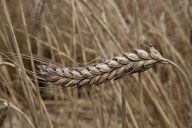
Emmer wheat, the most common type from which the ancient Egyptians made bread
Temple walls show grain growing out of the body of the dead Osiris while His soul hovers above the stalks. But it is not enough that the grain sprouts and grows. It must also be transformed so that Osiris Himself may also be transformed. And, as in the main Isis and Osiris myth, the Goddess is the one Who transforms the God. In the myth, She does this by reassembling His body and fanning life into Him with Her wings. Using the grain metaphor, Isis becomes the Divine Baker Who transforms the raw grain into the risen and nourishing bread. In the Book of Coming Forth by Day, the deceased person asks for a funeral meal of “the cake that Isis baked in the presence of the Great God.”
As a symbol of transformation and ongoing life, grain has magical properties. Some of the funerary texts have the deceased rubbing her body with barley and emmer wheat in order to partake of these magically transforming properties.
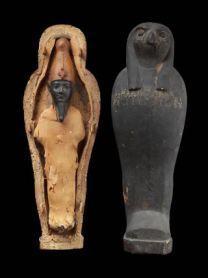
A “corn Osiris” … perhaps molded like the larger Divine Bread of Mendes?
In several temples where important festivals of Osiris were held, the priests made a complex form of bread, called Divine Bread, that was molded in the shape of Osiris. (In fact, the ancient Egyptians were quite adept at using molds to bake bread in a variety of shapes and forms.) The Osirian Divine Bread was made from grain and a special paste consisting of ingredients such as Nile mud, dates, frankincense, fresh myrrh, 12 spices with magical properties, 24 precious gems, and water.
At Denderah, this Divine Bread was modeled into the shapes of the pieces of the body of Osiris and sent to the various cities in which Isis was said to have enshrined them.
At Mendes (which is where, we must note, the phallus of Osiris was enshrined), a sacred marriage was part of the Osirian celebrations. It took place between the Goddess Shontet, a form of Isis, and Osiris as the grain. In the Goddess’ holy of holies, Her sacred statue was unclothed and grain was strewn on a special bed before Her. After allowing some time for the Goddess and God to unite, the grain was gathered up, then wrapped in cloth, watered, and used to model a full-body figure of Osiris Khenti-Amenti (“Osiris, Chief of the West,” that is, the Land of the Dead). Finally, Osiris the Divine Bread was buried with full ceremony, including a priestess who took the role of Isis to mourn Him and work the transforming magic of the Goddess.
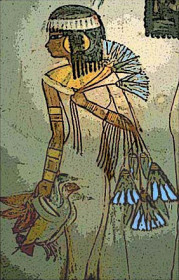
Gathering lotuses for the lotus bread
Several ancient writers describe an entirely different type of bread also associated with Isis. It is lotus bread. According to Herodotus, the Egyptians who lived in the Delta gathered the lotuses that grow profusely there. They dried the centers containing the seeds then pounded them into flour that was made into bread. Lotus-seed bread was made from both the white and the blue water lilies. The lily rhizomes were also used; they were dried, then ground into flour for bread making—though the rhizome version was likely to have been less palatable than the seed bread. In Diodorus’ account of Egyptian prehistory, he mentions that lotus bread was one of the Egyptian subsistence foods and that the “discovery of these is attributed by some to Isis.”
Isis is the Lady of Abundance Who gives us the bread of earthly life; and She is the Divine Baker Who makes the magical bread that gives us eternal life. She is the Goddess Who regenerates the Grain God as She guides the transformation of Her Beloved from the threshed grain into the ever-living Green God Osiris. She is the Goddess of Divine Bread Who feeds our bodies and souls and Her sacred bread is a pleasing offering to Isis, Goddess of Transformation.
Filed under: Goddess Isis Tagged: Aspects of Isis, bread, Divine bread, Egypt, Egyptian magic, Egyptian Temples, Goddess, Goddess Isis, Goddess worship, Grain God, Grain God Osiris, Isis, Isis worship today, Lady of Bread and Beer, Osiris, Who is Isis?




